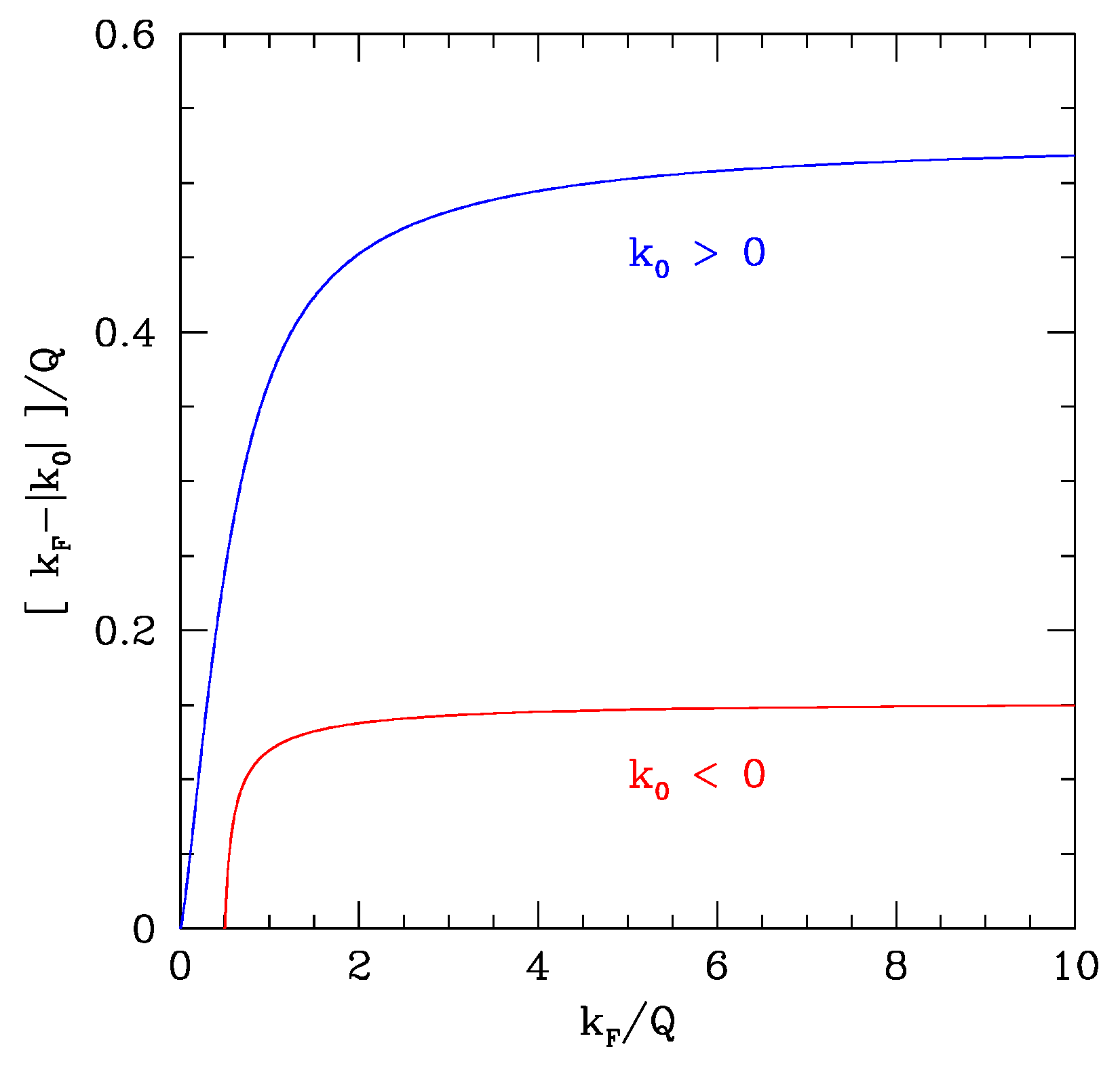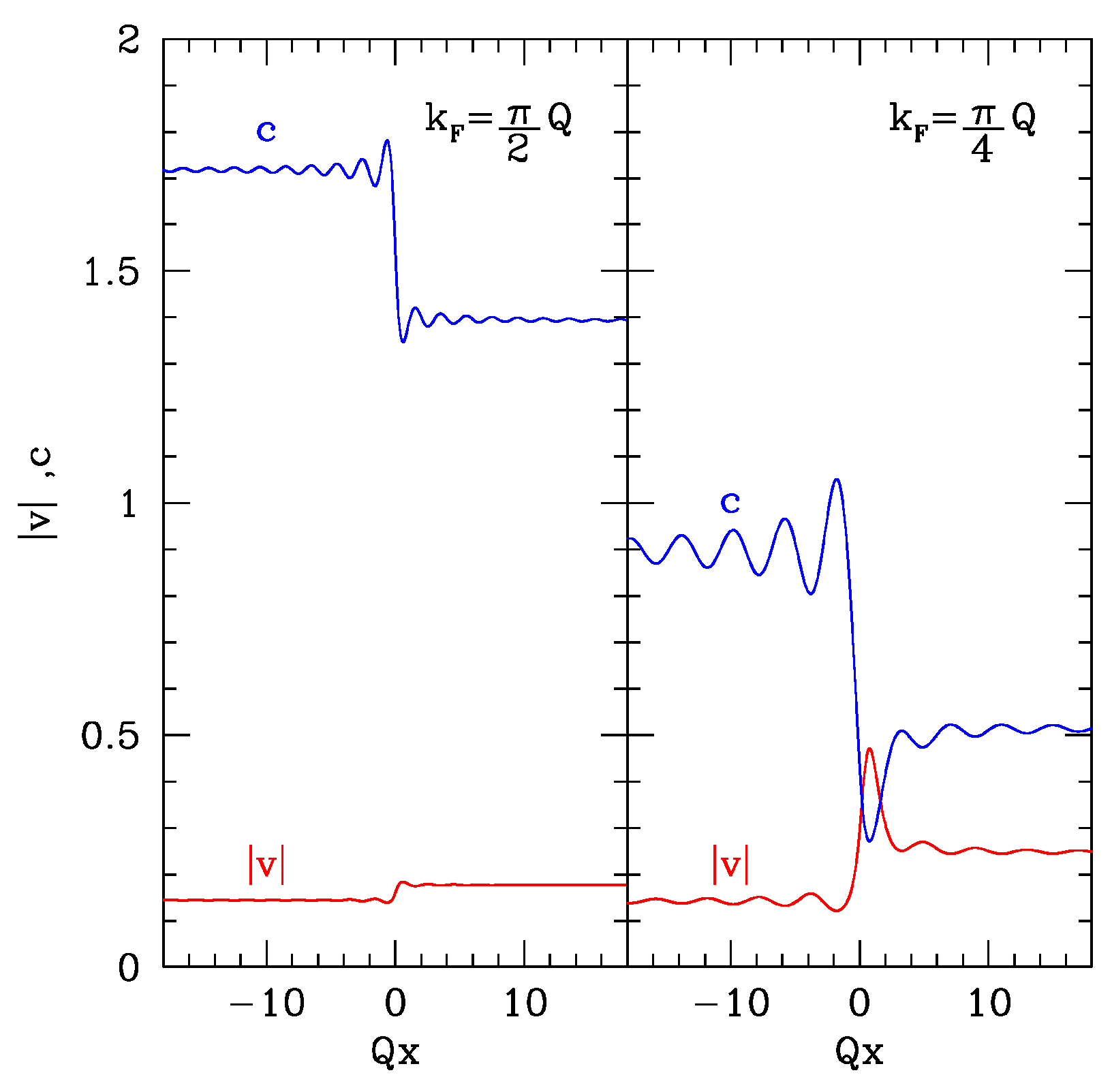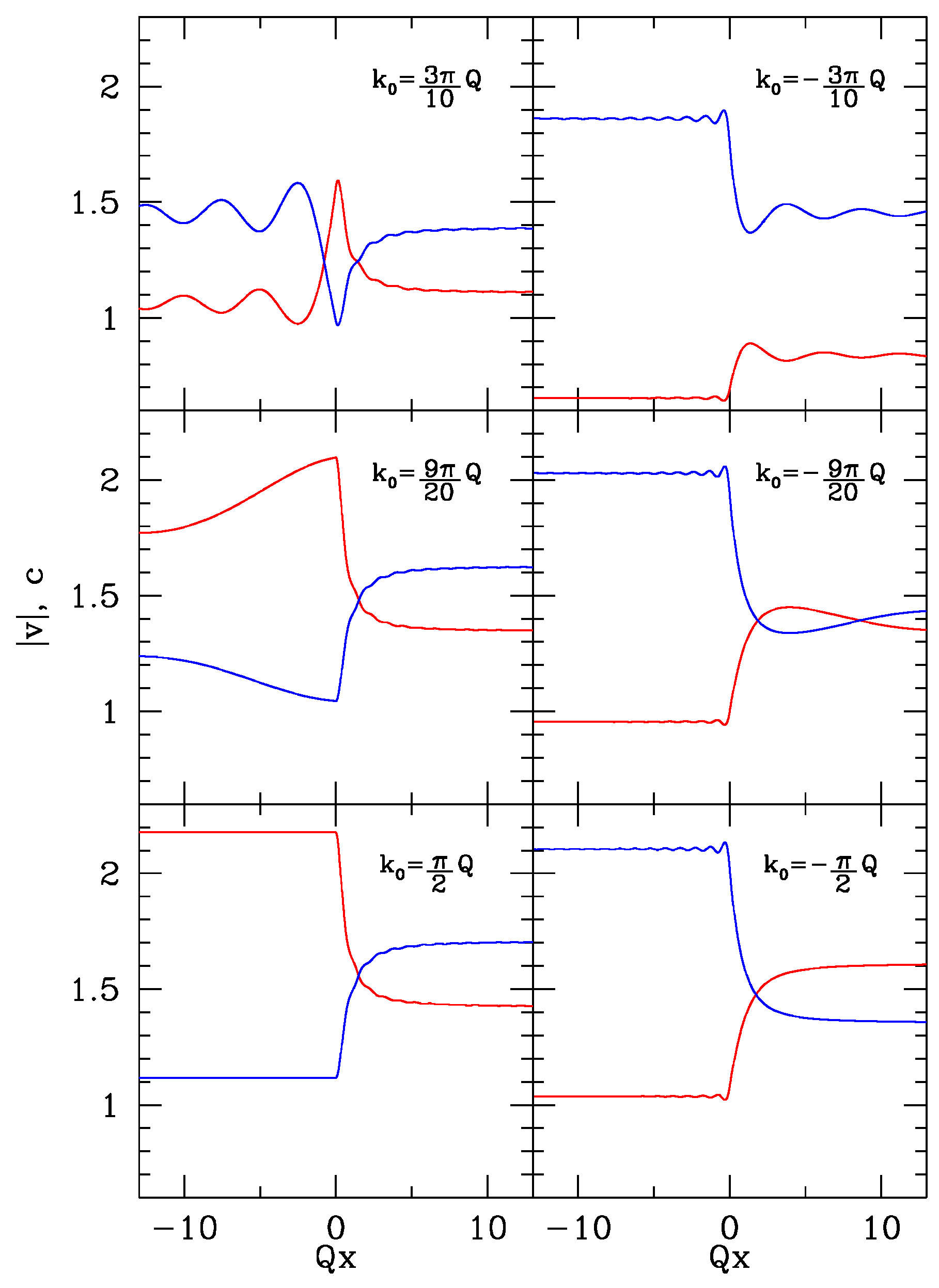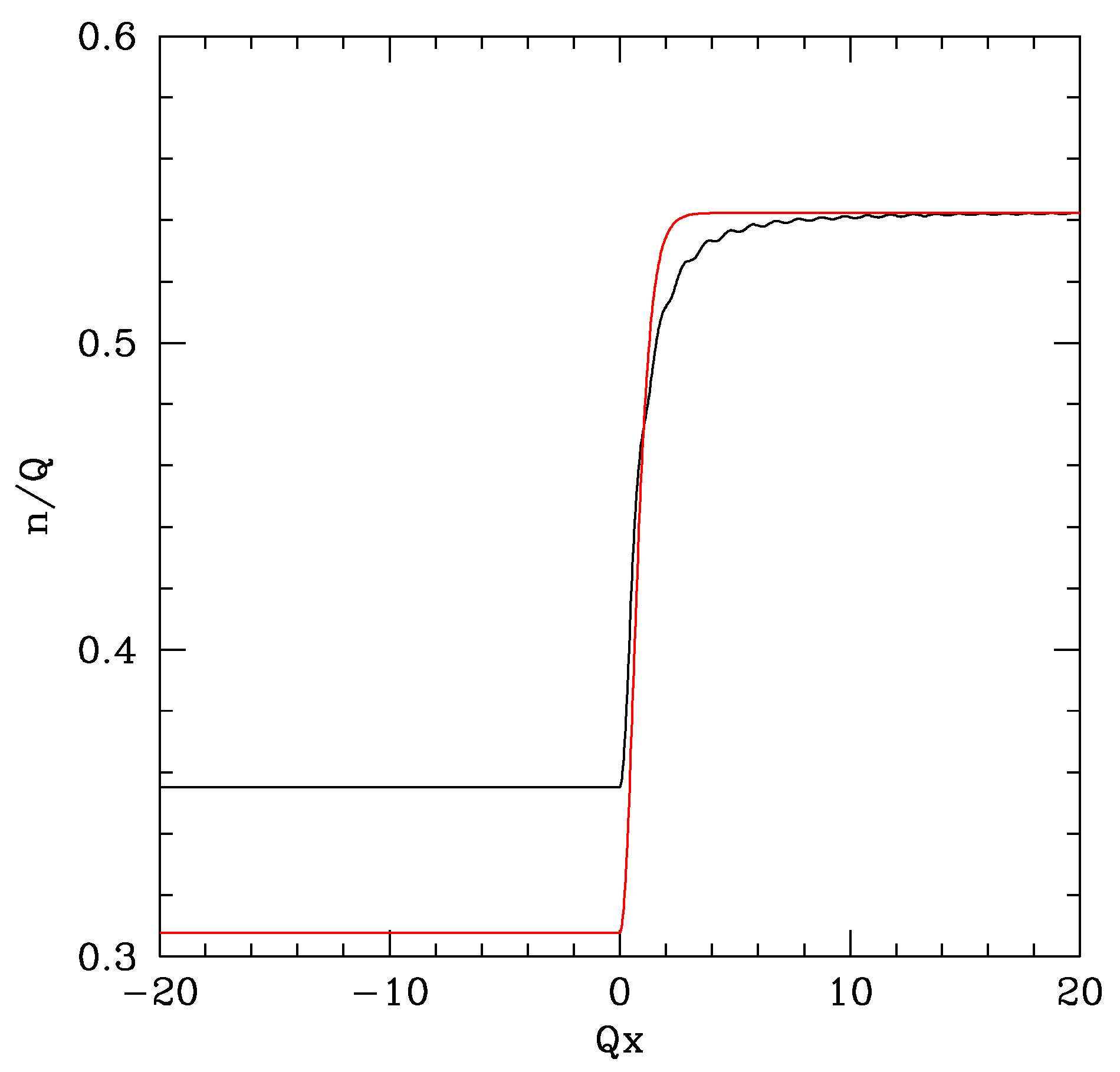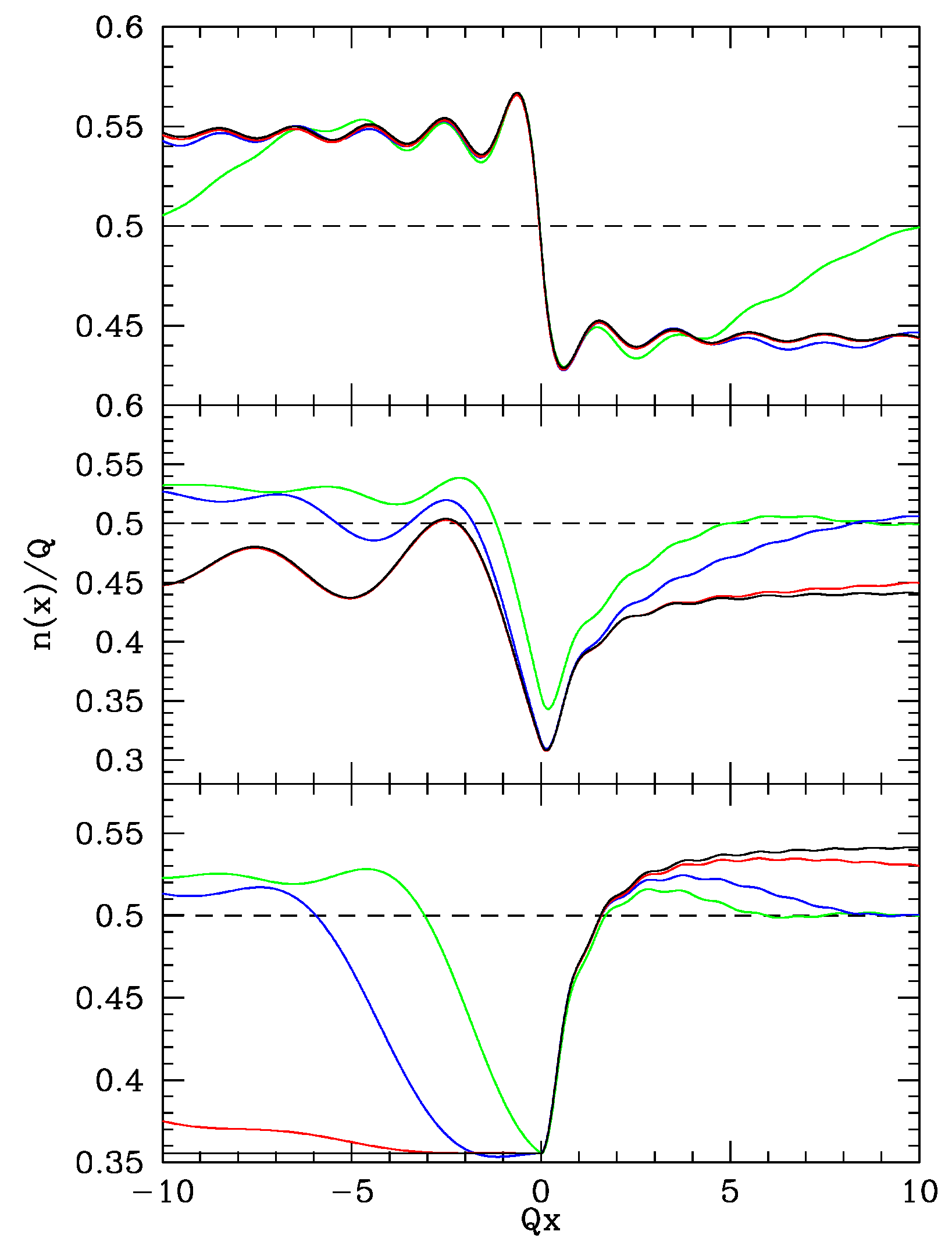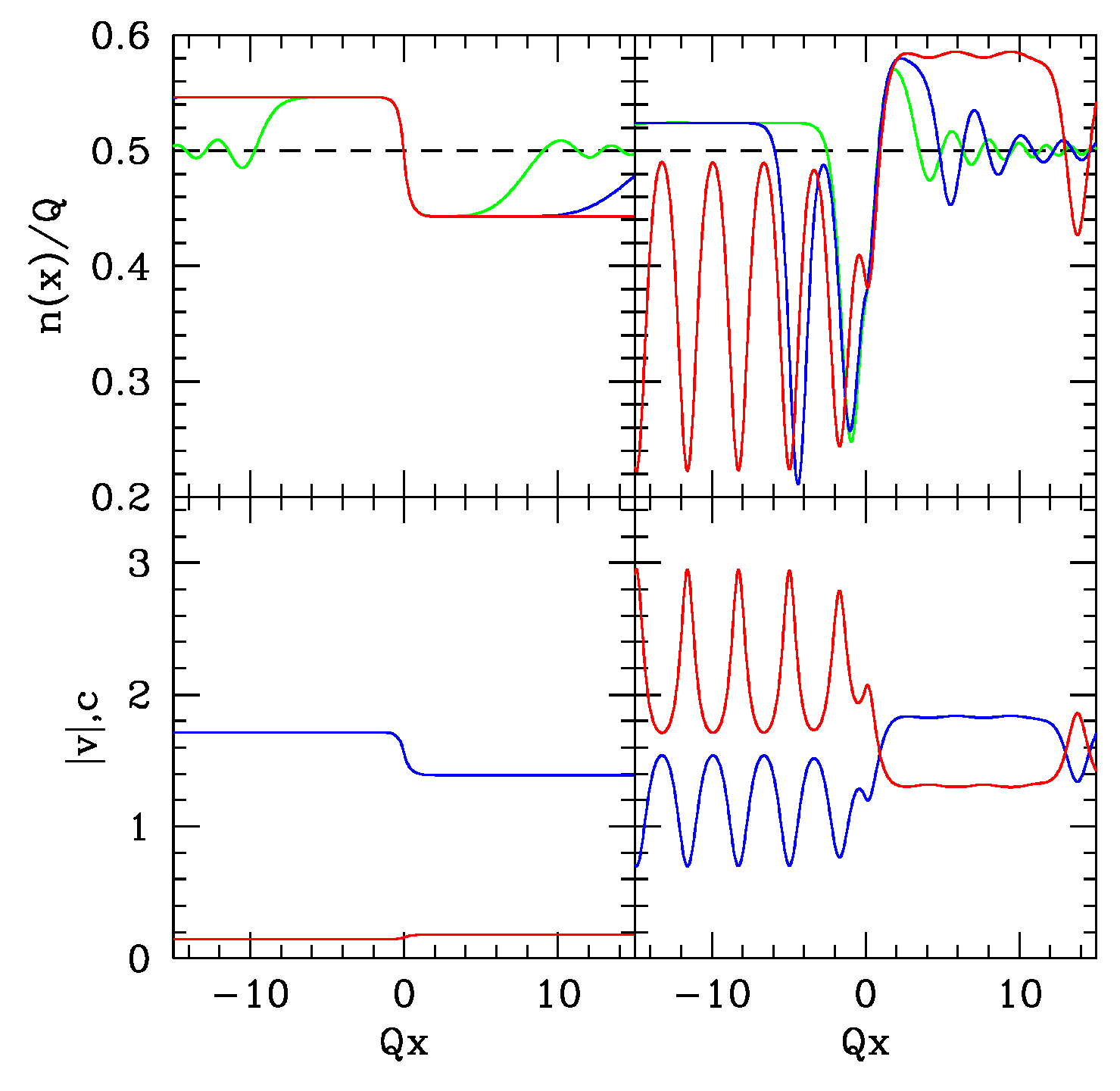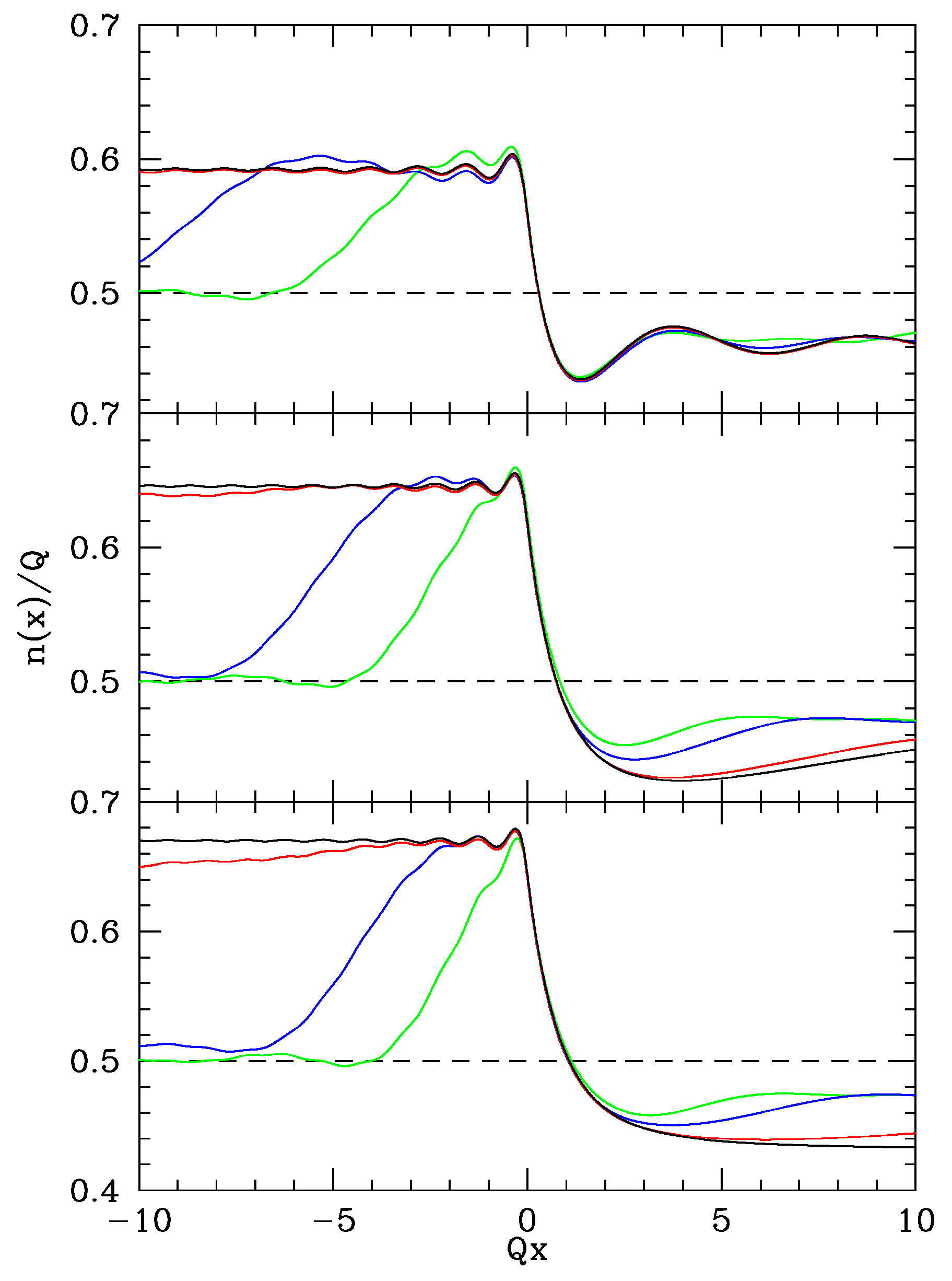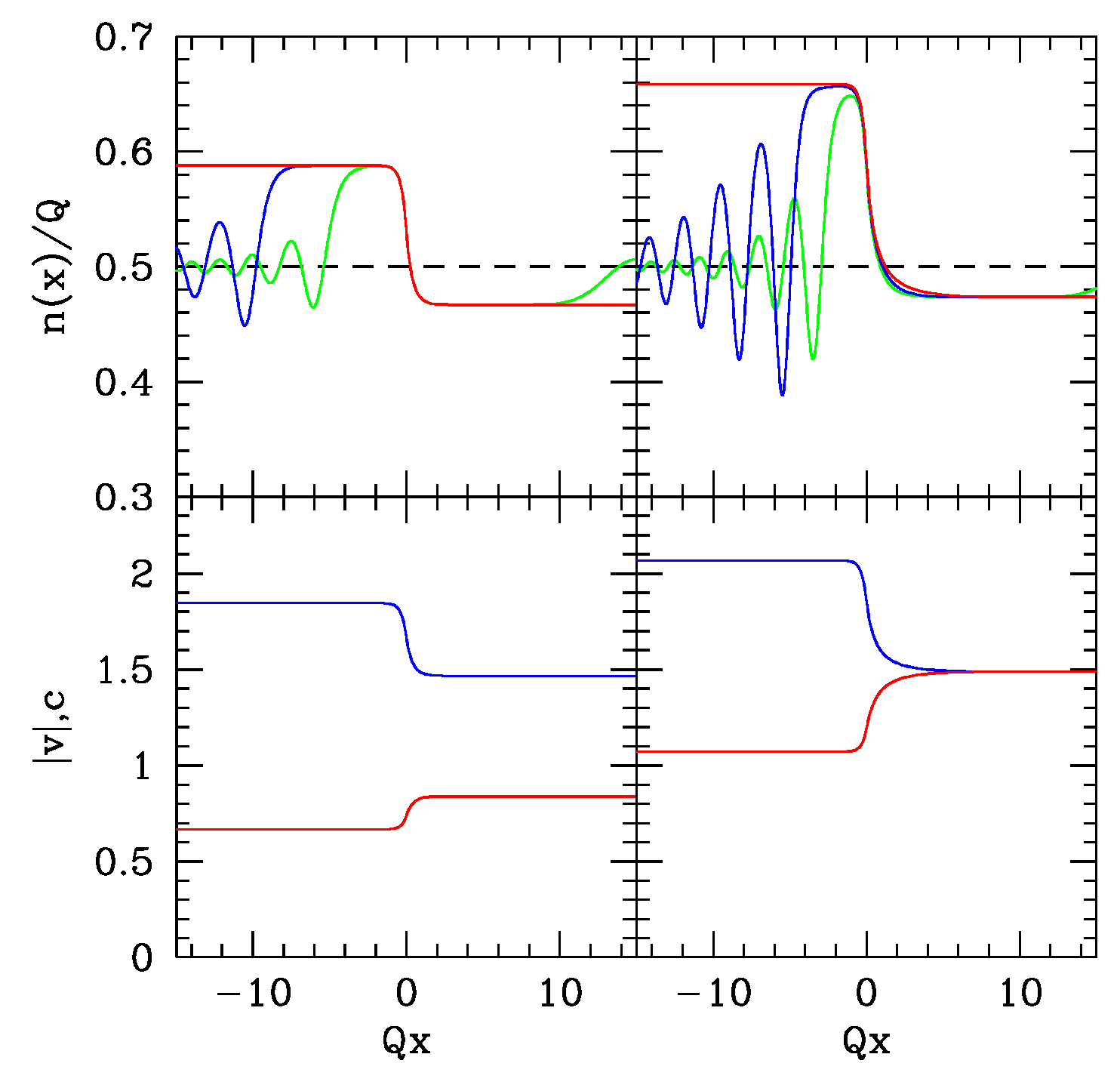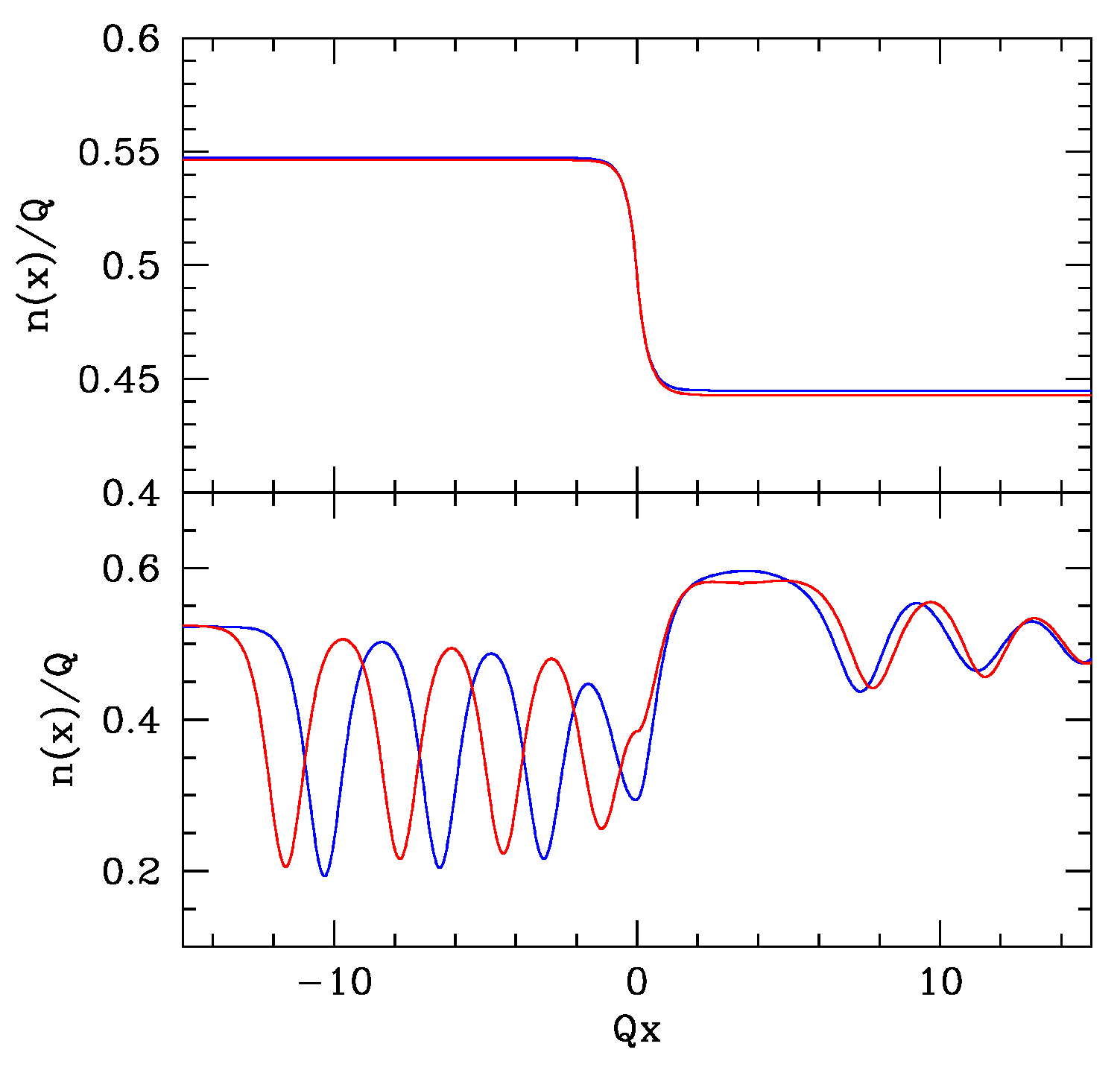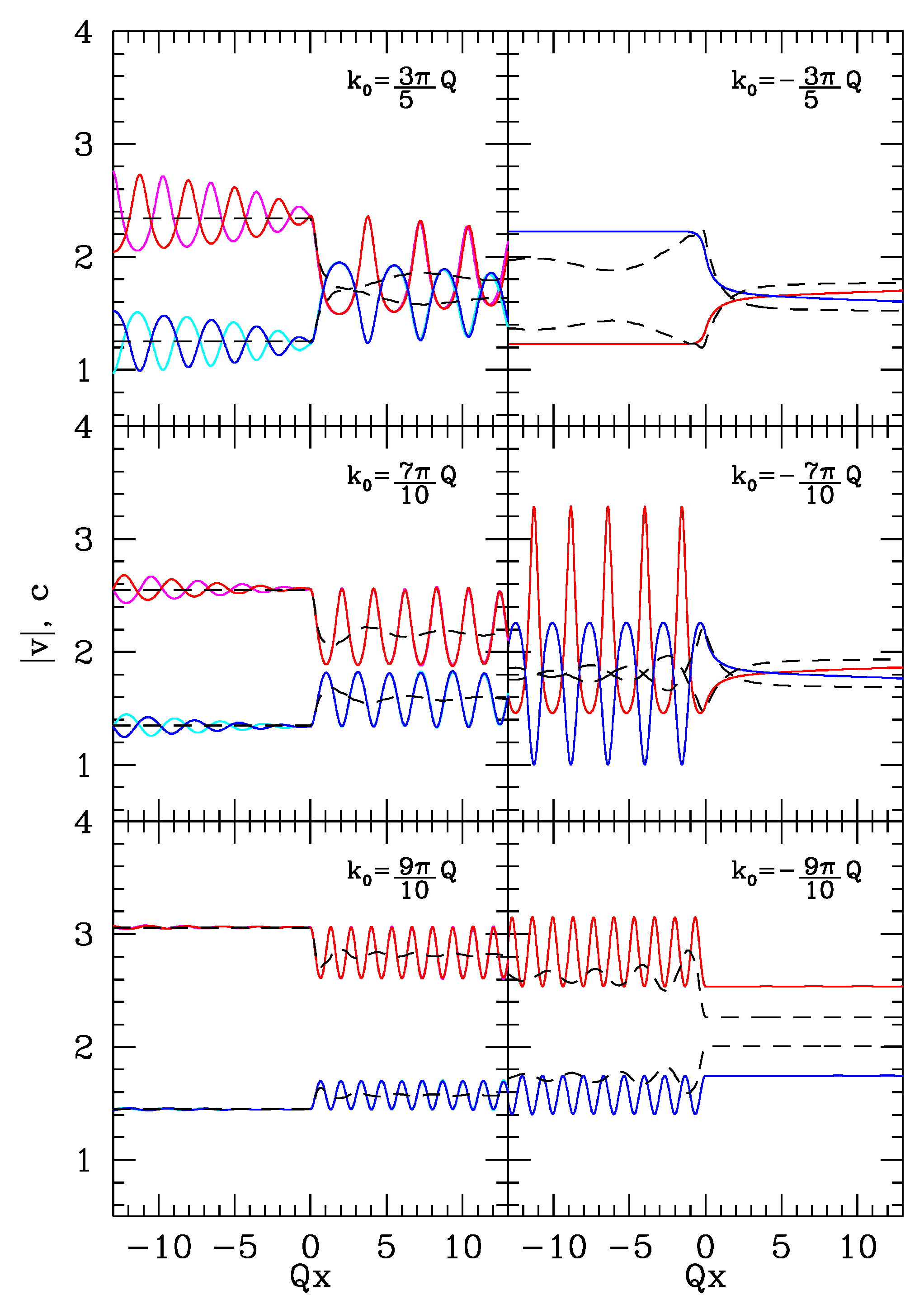1. Introduction
Analogue models of gravity are useful tools bridging gravitation to other branches of physics and they have been intensively investigated since their proposal [
1] in order to study effects whose experimental achievement is hardly possible in the cosmological context. In recent years, a great scientific effort was dedicated to the observation and characterization of the Hawking effect [
2,
3] but several different phenomena can be investigated within the analogue gravity paradigm [
4]. In particular, the physics of sonic horizons [
5] has been vastly studied, both from a theoretical and an experimental point of view and analogue black-hole and white-hole horizons have been experimentally achieved in optics [
6,
7,
8], in Bose–Einstein condensates (BECs) [
9,
10,
11,
12,
13], in water [
14,
15,
16,
17,
18], in superfluid Helium [
19], and in a few other setups. In the context of BECs, a few recent experiments [
10,
11,
12,
13] successfully recreated sonic horizons in order to probe the elusive Hawking radiation but the results are still under debate in the scientific community [
20,
21,
22,
23,
24,
25,
26,
27,
28]. Nonetheless, these experiments represent a remarkable achievement and they have stimulated a variety of theoretical studies on sonic black holes in 1D BECs. One feature, though, which has not been deeply investigated in these kind of configurations is the formation dynamics of an analogue black/white hole; this may be due to the fact that analogue models can hope to reproduce only the kinematical aspects of the gravitational phenomena, as the analogy breaks down for the dynamical properties. For this reason, theoretical studies often start from an “eternal” (analogue) black-hole, i.e., from a configuration which already shows a sonic horizon, neglecting the question of how it may have formed.
In this work we will study the dynamics of formation of a sonic horizon for a simple, realistic model of BEC which mimics existing experimental configurations [
9,
10,
11,
12,
13]. In particular, we will exploit a recently proposed exact model [
26,
27] in order to study the dynamics of the analogue of a gravitational collapse in the absence of external confining traps and to investigate whether the system only forms black-hole-like horizons or if a dynamical process could, in principle, lead to a formation of a white-hole horizon too. Furthermore, we will compare the results with those obtained with a semiclassical approach—commonly adopted in the theoretical interpretations of the experiments—in order to highlight possible inadequacies of the semiclassical paradigm. This will give insights on the formation process of analogue horizons and, interestingly, will also lead to challenge the “eternal” black-hole configuration as a tool to study the Hawking effect.
2. Tonks–Girardeau Gas
We consider a one-dimensional Bose fluid of hard-core, point-like particles in an external potential
. The model hamiltonian is written, in first quantization, as
where the hard-core constraint corresponds to the strong interaction limit
. In the absence of external potential
, eigenvalues and eigenfunctions of this hamiltonian have been found for any value of
c by Lieb and Liniger [
29] using Bethe Ansatz techniques. In the hard-core limit, the Lieb-Liniger solution can be more easily obtained by performing a Jordan-Wigner transformation which maps the hard core Bose fluid into a non-interacting, spinless, fermion model [
30]. A simple argument allows understanding this exact result: in one dimension the spatial ordering of hard-core bosons cannot be modified by a local hamiltonian. Therefore, the different phases acquired by bosons and fermions upon particle exchange do not come into play and the matrix element of the hamiltonian between two arbitrary bosonic configurations coincides with the corresponding matrix element of the free spinless Fermi gas. Interestingly, this result remains valid also in the presence of an arbitrary external potential, but clearly the argument fails in more than one dimension, where a natural ordering cannot be defined. Due to this mapping, the full spectrum of the hamiltonian (
1) and the many-particles dynamical density correlations coincide with those of a non-interacting Fermi fluid in the same external potential
. Please note that instead, the momentum distribution of the Bose gas differs from that of the corresponding Fermi system due to the non-locality of the Bose-Fermi mapping defined by the Jordan-Wigner transformation.
Exactly solvable models represent a unique tool as a test ground for approximate theories, which are the only possible option in most cases. Among the approximate descriptions of a weakly interacting Bose fluid, the celebrated Gross–Pitaevskii equation (GPE) [
31] stands out as a simple and accurate method to portray the dynamics of the condensate wavefunction. The inclusion of a cubic non-linearity in the Schrödinger equation suffices to account for weak interparticle interactions, providing a satisfactory description of many experiments in cold atom physics [
31]. The Tonks–Girardeau (TG) gas is a strongly interacting Bose fluid and therefore the usual semiclassical approaches for the approximate description of the dynamics are not expected to provide accurate results. However, it is known that a simple generalization of the Gross–Pitaevskii equation does indeed faithfully reproduce the physics of a Tonks–Girardeau gas [
32,
33], at least in homogeneous systems. Such a “strong coupling limit” of the usual (cubic) GPE displays a quintic non-linearity with a specific value of the coupling constant
:
In the Gross–Pitaevskii approximation, the global properties of the flowing Bose gas are identified with those derived from the single particle wavefunction
. In particular, in the homogeneous case (
), the phonon excitation spectrum derived from Equation (
2) coincides with the exact one, defined by a sound velocity
c, related to the fluid density
n by the same expression valid for a one-dimensional Fermi gas:
. The dynamics described by the Gross–Pitaevskii equation will be compared with the exact results in order to verify the accuracy of the widely adopted semiclassical approximation in the context of analogue gravity experiments in BECs.
3. The Model
The Tonks–Girardeau gas model has been recently studied in the framework of analogue gravity [
26,
27] because it allows describing, from a microscopic point of view, the dynamics of formation of a sonic horizon and to investigate the physical conditions leading to the expected Hawking-like phonon flux emerging from the horizon. The analytical and numerical studies of Ref. [
26,
27] proved that a precise correspondence between the physics of the analogue model and that of the Hawking effect can be obtained only when the TG gas flows against an extremely smooth potential barrier. The rationale for this result is that the identification of the quasiparticles (phonons) as a free quantum field is possible only for very low excitation energies and (almost) homogeneous states. Instead, sharp potentials, such as those usually adopted in the experiments, give rise to a steady state characterized by a rapidly varying density profile, whose elementary excitations cannot be expressed as a free field with a locally varying sound velocity, as requested by the analogy to the gravitational problem. Remarkably, a sharp external potential does not seem to suppress the Hawking effect: in the steady state a phonon flux may indeed be present but it is not described by a thermal distribution and therefore it cannot be associated with a well-defined Hawking temperature. We stress that these results have been obtained [
26,
27] for the Tonks–Girardeau gas in one dimension, where the occurrence of thermalization after a quantum quench is hampered by the integrability of the model [
34]. On the other hand, at variance with the case of a potential barrier, an extremely smooth potential step does not lead to the formation of a sonic horizon, making such a configuration unsuitable for the investigation of the Hawking effect [
26,
27]. Finally, it has been thoroughly discussed in [
26,
27] that, even though the hard core limit may appear as a strong assumption which is hardly ever achieved experimentally [
35,
36], the conclusions drawn from that model can be generalized also for the case of weakly interacting gases. This, as we will show, can be said for the results derived in this paper too.
In this work we will examine the formation dynamics of black- and white-hole horizons when a flowing TG gas is perturbed by the sudden switching-on of a sharp step potential. In the experiments, this procedure has been adopted in quasi one-dimensional BECs in order to create either a sonic black-hole horizon [
11,
12,
13] or a black/white hole pair in order to trigger the so-called “black-hole laser” effect [
10]. As the analogue gravity paradigm shows, the first is obtained when the fluid passes from subsonic to supersonic (in the direction of the flow) while a white-hole horizon is the exact opposite, i.e., when the fluid passes from a supersonic region to a subsonic one. Indeed, in the first case phonons cannot exit the supersonic region (the analogue of the interior of a black hole) while in the second they are forced to do so (the analogue of a white hole indeed). According to the experimental configurations and to our previous theoretical studies [
26,
27], we choose a left-moving gas flowing over a “waterfall” potential as a preferred setup but we will generalize our investigation to also describe the opposite flow.
Thus, we start from a flowing TG gas in a stationary state which is described, via the Bose-Fermi mapping, by a Slater determinant of plane waves
; the wavevectors
p belong to the interval
, where
is the Fermi momentum in the co-moving reference frame and
is the momentum shift due to the fluid flow; these two parameters, characterizing the initial state of the system, are related to the uniform particle density
, sound speed
and fluid velocity
. We therefore adopt the convention that a positive value of
corresponds to a left-moving flow. Then, at
, we suddenly turn on the step potential
where
is the potential height which is conveniently parametrized
1 through the wavevector
Q:
. Immediately after the quench the fluid is not in a stationary state any more and its many particle wavefunction evolves in time. Adopting the fermionic representation, at any time
the wavefunction is given by the Slater determinant of the time evolution of the initial plane waves:
where
are the exact single particle eigenfunctions in the presence of the external potential,
the corresponding energy, and
is the usual convergence factor. For a step potential
and the eigenfunctions
are easily obtained by elementary methods:
while no eigenfunction exists for
. Here
and
. The explicit expressions of the reflection and transmission coefficients are reported in [
27].
4. Steady States
While the full dynamics after the quench requires a numerical analysis starting from Equations (
4) and (
5), the long time behavior can be analytically evaluated. As shown in Ref. [
27], at any given fixed position
x, the local physical properties of the model approach those given by the stationary state built upon the wavefunctions
given by:
with
. As a consequence, for each choice of the two parameters
a steady state exists, characterized by the number density profile
and by the mass current
which is constant in space and time. By direct substitution of the scattering eigenfunctions in Equation (
9) we get the explicit results:
for
and
for
, where
and
. The occupation number
identifies the region in momentum space occupied by fermions:
for
and
elsewhere. These expressions allow evaluation of several important quantities in the framework of the analogue gravity: the local fluid and sound velocity,
and
respectively, together with their ratio, i.e., the Mach number:
The analytical expressions show that in the limiting cases the density profile is rigorously flat in the region , leading to a uniform fluid velocity. The same can be said for the region when . At first, though, we will consider only the cases of as the condition ensures that the flow is initially subsonic.
The integrals can be easily evaluated for both the particle current and the asymptotic densities at
and allow evaluating the range of parameters leading to a steady state characterized by a single supersonic transition.
Figure 1 summarizes the results: the blue curve refers to a left moving fluid (
) with subsonic velocity at
which gets accelerated by “falling into the waterfall” and becomes supersonic at
if
lies below the blue line. Instead, the red curve shows that a right moving fluid (
), which starts subsonic at
, can get supersonic flowing against the step potential if
belongs to the region below the red line. In this case, however,
must exceed the minimum value
. In both cases, a black-hole horizon forms close to
, only for sufficiently high initial velocities:
.
The steady states corresponding to an initially still Fermi gas, i.e., a vanishing
, display a finite particle current due to the sudden appearance of the waterfall potential, leading to a leftwards motion (i.e., with negative velocity) of the fluid. For this case, two velocity profiles are shown in
Figure 2 for
and
: while in the former case the steady state is always subsonic, in the latter a supersonic flow sets in a finite region around
, giving rise to a pair of black-hole/white-hole horizons, i.e., to a region where the flow passes from subsonic to supersonic and then becomes subsonic again.
When we start from a fluid which is already moving (i.e.,
), the long time characteristics of the flow velocity and of the sound speed show different possible behaviors. Illustrative plots of the stationary velocity profiles for a few representative choices of
at fixed
are shown in
Figure 3 for both cases of a fluid falling into the waterfall (
, left panels) and flowing against the step potential (
, right panels). While for
Figure 2 shows that the fluid motion is subsonic, when
is increased (i.e., when the fluid falls from the potential step) a small supersonic region appears close to the step (see the case
). Further increasing
(see
) the flows becomes supersonic in the whole downstream (i.e., left) region. At
the velocity becomes constant for all
, as previously discussed. The case of a fluid flowing against the step potential (right panels) is qualitatively similar, showing a fully subsonic flow for
, a black-hole/white-hole pair at
and a single supersonic transition at
. In the latter case, however, the fluid velocity is not constant in the downstream (i.e., right) region. In all the cases, the undulations present both in the upstream and downstream regions are due to the presence of a sharp Fermi surface.
Please note that the steady state solutions discussed here are not invariant by time reversal. As the hamiltonian real, the complex conjugate of the single particle wavefunctions (
9) are still exact eigenfunctions for the free Fermi gas; the time reversal of a
scattering state, however, is not a scattering state but is written as a particular linear combination of the two scattering states. Therefore, the Slater determinant of the time-reversed states describes a different stationary state of the system with the same density profile and opposite current
j, as shown by Equations (
10) and (
11): wherever the original solution displays a black-hole (BH) horizon, the time-reversed state predicts a white-hole (WH) horizon. However, we stress that, according to the analysis leading to Equation (
9), the time reversed state does not describe the stationary solution spontaneously reached by the system after a quench.
It is interesting to compare these exact results with the stationary states of the corresponding Gross–Pitaevskii equation, to check whether the semiclassical approach is able to capture the variety of behaviors displayed by the TG gas model. Looking for solutions to Equation (
2) of the form
we obtain a non-linear differential equation whose solutions can be found analytically in the case of a step potential
, where
is the Heaviside function. The generic stationary solution depends on two parameters: the chemical potential
and the current
j. The equation has real coefficients and then each stationary solution has a time reversal partner with opposite current: the direction of the particle flow is reversed by keeping the same density profile. Restricting our analysis to solutions leading to density profiles asymptotically flat
2 for
, we generally find only monotonic decreasing density profiles and fully subsonic flows. Only for a special relationship between
and
a different solution appears, displaying a supersonic transition, which might represent either a BH or a WH horizon according to the sign of
j. The density (and velocity) profile is flat for
while is monotonically increasing for
: this solution corresponds to the “half soliton” profile in full analogy with the known results valid for the standard (cubic) GPE [
37]. The analytical form of the half soliton for the quintic GPE is
where the modulus and the phase are expressed in terms of the unique parameter
Along the positive semi-axis
we have
where
and the asymptotic density
is expressed in terms of the parameter
by the algebraic equation:
For
, as previously stated, the density is constant and the phase linear in
x. This analysis shows that the GPE is not able to reproduce, even qualitatively, the exact solution when a supersonic transition is present and the supersonic flows have non-monotonic profiles with a well defined limit for
(see
Figure 3). Only the special case
appears to be related to the “half soliton” solution of the GPE, although the agreement is not quantitative (see
Figure 4): if the parameter
is chosen so that the
limit of
coincides with the exact value, the uniform density in the supersonic region is underestimated and the profile close to the transition point is not correctly reproduced.
7. Further Possible Configurations
The analysis carried forward in the previous Sections starts from the assumption that
, which means that initially, when the potential is switched off, the fluid has a subsonic (at most sonic) velocity. For completeness, we will now relax this hypothesis and investigate what happens if the gas initially flows at supersonic speeds. Equations (
12)–(
14) provide the expected density profile and the particle current at stationarity also for
.
Following the previous discussion, we can study the dynamics of the gas after the quench numerically and we can investigate the possible formation of a sonic horizon both within the exact dynamics and according to the semiclassical (GPE) approximation. One would expect that a supersonic homogeneous gas subject to an external waterfall potential would not give rise to a sonic transition, but, instead, the switching-on of the step potential introduces various interesting configurations as we will now describe in some detail.
Let us start with a left moving gas flowing over the potential step. If we choose a value of the initial gas velocity which is slightly bigger than the sound speed (
), the exact evolution drives the system towards a stationary state displaying a sonic horizon. By further increasing
this region shrinks until the fluid is supersonic on the whole axis. The dashed line of
Figure 10 illustrates this behavior: indeed, the upper left panel shows a value of the initial velocity for which the subsonic region consists in one point, while in the central and bottom left panel the flow is always supersonic. Instead, the long time behavior of the semiclassical (GPE) solution shows an oscillation pattern in the upstream region and a train of solitons in the downstream region, thus never leading to the exact stationary state. This is found to be true for any value of
, as
Figure 10 shows. Also, as noted in
Section 4, under this circumstances the exact solution is always flat in the downstream region.
The right panels of
Figure 10, instead, report the long time evolution of a right moving fluid. The exact results (dashed lines) show that in a range of velocities
a BH horizon is formed: the flow upstream is subsonic and a supersonic transition occurs near the position of the step. By further increasing the value of the initial velocity the subsonic region becomes finite until it disappears, leaving a supersonic flow everywhere. Interestingly, it can be seen that both the exact and the semiclassical solution tend to a finite value in the downstream region while the two are significantly different in the upstream region: while the exact solution has smooth behavior, the semiclassical one develops spatial oscillations. Also, as already noted in
Section 4, the exact solution is always flat in the downstream region if
(bottom panel).
8. Conclusions
We have studied, both analytically and numerically, an exactly solvable model describing a flowing one-dimensional Bose gas, in order to shed light on the physics underlying the analogue gravity paradigm. This model of hard-core bosons enables following the formation dynamics of black- and white-hole horizons after an external step potential is switched on: the analogue of a gravitational collapse event. Indeed, the fluid starts from a situation of constant density and velocity and, after a quench, it reaches another stationary configuration. From a curved spacetime point of view, this process is the exact analogue of Hawking famous
gedankenexperiment [
3]. Accordingly, a phonon flux emerging from the black-hole horizon is expected [
26,
27]. The presence of an outgoing heat flux in a stationary configuration is indeed possible in our one-dimensional geometry because the horizon cuts the space in two infinite regions. Furthermore, the shape of the external potential represents a realistic reproduction of existing experimental setups [
9,
10,
11,
12,
13] and a model used in various theoretical works (for example [
48,
49,
50,
51]).
We analytically found the stable stationary states of this model which allows for the existence of both black- and white-hole horizons, as well as black/white hole pairs. By numerical integration of the exact evolution equations, we found that if a horizon is formed after the quench, either an isolated black-hole horizon or a tight black/white hole pair is formed but a white-hole horizon can never be reached dynamically. This somewhat conforms with the analogue gravity paradigm: the positive black-hole entropy allows for the spontaneous formation of an horizon, while the negative white-hole entropy does not. Moreover this study suggests that a sufficiently tight black/white hole pair is not necessarily unstable, at least in analogue models, while our solutions confirm that both a single black/white hole is a stable solution of the dynamical equations.
Furthermore, we compared these findings with the solutions for a semiclassical equation usually adopted to describe this class of models: i.e., the Gross–Pitaevskii equation, here suitably generalized to deal with a strongly interacting Bose gas. We found that only a subset of all possible stationary states are described by the GPE, including the subsonic solutions (with no event horizons) and the single black hole case, for a specific value of the mass current. However, the dynamics described by the GPE does not lead to the formation of a stationary solution whenever a sonic transition is present: indeed, starting from a uniformly flowing Bose gas, the semiclassical evolution gives rise to density waves propagating outwards which are not damped in time, preventing the convergence towards the stable stationary solution of the GPE. This behavior, which is a general feature also for the usual cubic GPE, suggests that results based on the integration of non-linear Schrödinger equations should be critically considered, at least as far as the long time dynamics is concerned.
Finally, to complete the description, we show other possible configurations leading to the formation of one (or more) sonic horizon which can be achieved by further increasing the initial velocity of the gas.
On a final note, the results obtained in this work provide an important step for future possible investigations, as they give insights for new possible experimental configurations, they represent a key ingredient for the study of the hydrodynamical instability (and gravitational effect) known as black-hole laser and they help understanding the bounds on validity of semiclassical methods. To this extent, a question which arises from these results is what the optimal black-hole configuration should be in order to study the analogue of the Hawking effect. In fact, on one hand, as Hawking already pointed out [
2], the dynamical history of the gravitational collapse should not affect the emitted radiation, but, on the other hand, his line of thought heavily rests on the comparison between a precise initial and final stationary state, which we are able to identify through the exact solution of the model but not by means of semiclassical approaches.
